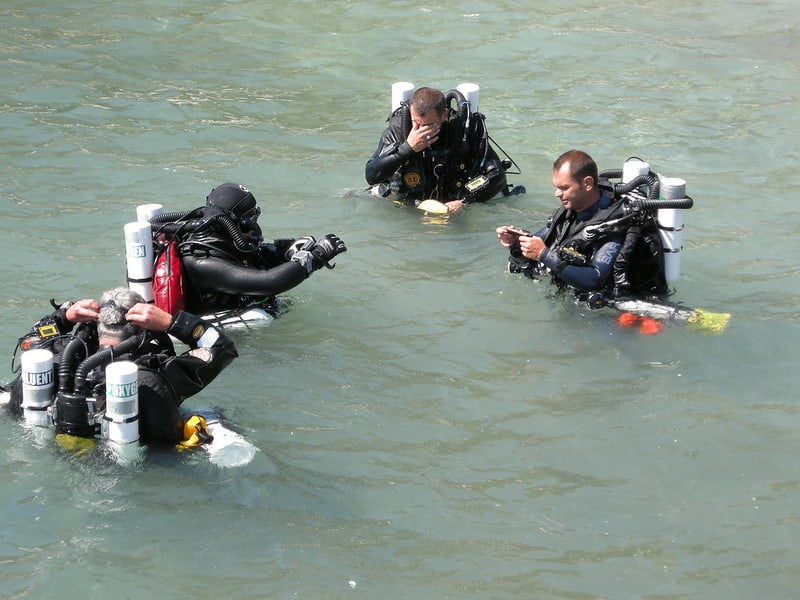When you become more experienced in diving, some advanced gear can allow you to challenge yourself or just simply go deeper. However, these tools usually require proper training and professional skills. Otherwise, your safety is endangered.
According to technical divers, most of their deaths are related to the rebreather – a kind of dive gear allowing you to be close to marine life. Besides, this diving equipment facilitates breathing, improves gas efficiency, and supports underwater photography.
To provide you with an overview, I have written this article that aims to present to you the operation of a rebreather. Besides, I also attached detailed sections about its pros and cons to see why it might be needed for your next dive trip.
Table of Contents
What is a Rebreather?
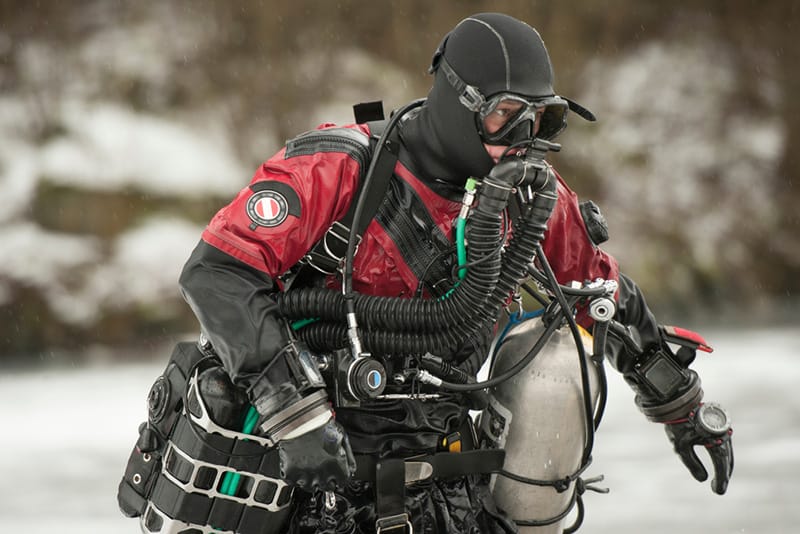
A rebreather is an apparatus that facilitates breathing when you are below the surface. It can recycle exhaled gas for reuse, which means you can stay underwater longer. The rebreather’s design enables it to take advantage of a limited gas supply for as long as possible.
The process occurs when your exhaled air is wholly removed from carbon dioxide by using a canister, plus extra pure oxygen is injected in case the amount of unused one remains too low. Thanks to that, your consumed supply of air has been breathed again and again.
What’s more, this equals the fact that you will not need a bulky high-capacity scuba tank to stay underwater for hours. With a compact rebreather worn on your back, it is more effortless to propel your body forward through powerful kicks caused by a pair of diving fins.
A rebreather has some overwhelming upsides compared to an open-circuit breathing apparatus, commonly known as the scuba regulator.
| Scuba regulators | Rebreathers | |
| Strengths | ● Suitable for divers of all levels, especially beginners, thanks to the simple design. ● More popular. ● Easy to use. ● Require less maintenance. ● The price is more affordable. ● Ideal for recreational diving. | ● Unused oxygen can be recycled. ● Produce no bubbles. ● The bottom time is enhanced considerably. ● Integrated with dive computers to track the ascending process of a diver. ● Record your dive profile. ● Perfect for technical divers. |
| Weaknesses | ● Cannot eliminate bubbles. ● Unused oxygen is discharged along with consumed gas. ● Because the air supply is limited, divers cannot dive too deeply. | ● Require technological complexity in construction. ● More cumbersome. ● Only advanced divers with proper training can use. ● Come at a high cost. |
How Does a Rebreather Work?
At the beginning of the process, your exhaled gas enters a one-way breathing hose, passing through counterlungs and then returning to the mouth. One or two cylinders are at the back of a rebreather, depending on whether it is a semi-closed or fully-closed circuit.
For the exhaled air, the rebreather removes all the amount of carbon dioxide by using a canister of sodium hydroxide and recycles unused oxygen. At the same time, electronic sensors control the oxygen content to ensure it is always at an appropriate level.
If additional oxygen is needed, it will be automatically compensated thanks to an input valve on the inhalation counterlung. After that, newly added oxygen is mixed with unused one, creating a perfect blend for divers to breathe at any depth.
It is also noted that the refreshed breathing gas returns to the diver, and a new recycling cycle starts all over again. Thanks to that marvelous process, the amount of breathable air will always be maintained, reasoning why your bottom time is exceptionally extended.
However, to make your rebreather work safely and adequately, some procedures are considered even before and after a dive.
Pre-dive checks include:
- Fill cylinders. While most semi-closed circuit rebreathers use one, fully-closed circuit rebreathers use two, with one for pure oxygen and one for air. For some cases, you also need to refill a cylinder of your bailout system.
- Prepare a carbon dioxide scrubber. Pour absorbent, sodium hydroxide, or calcium hydroxide, for example, into the canister housing. Make sure all seals are tight because some kinds of absorbent will react with air and become useless.
Remember to wear gloves to protect your hands! You can use your scuba mask as a breathing one as well. - Assemble the rebreather. Semi-closed and fully-closed circuit rebreathers require different steps; understand which type you are using to avoid accidents.
The general procedure includes:
- Attaching a breathing hose to counterlungs.
- Use the loop to link these counterlungs with a carbon dioxide scrubber.
- Installing the cylinders.
You also must check all the valves in the breathing hose, counterlungs, and cylinders because they play a critical role in maintaining life.
Two leak tests should be done as well. Divers also need to control their electronic oxygen sensors daily to ensure no malfunctions.
Into the water should follow some tips:
- Keep in mind that the dive/surface valve on the mouthpiece must be closed to prevent water from entering the breathing hose. Otherwise, water will flood your mouthpiece and carbon dioxide scrubber, which is risky for your survival.
- Wear a scuba BCD if you want to control your buoyancy. A rebreather cannot help you do this because it tries to maintain the same amount of breathing air during the dive. Meanwhile, only a regulator allows for further adjustments through inhaling or exhaling.
- Be careful with air leaks!
- When you dive against strong currents, you consume more air than usual, which means extra oxygen will be needed. The rebreather must enrich the breathing blend with pure oxygen, or you’ll die.
- During ascending, your rebreather may not vent gas quickly enough; thus, you must do this manually to avoid excessive buoyancy.
Post-dive cleaning and maintenance include:
- Turn the rebreather off and check whether the water inside the breathing hose or not
- Disassemble, disinfect mouthpiece and breathing hose, rinse with fresh water, and dry well
- Avoid storing in direct sunlight
- Dispose of the used absorbent and clean the carbon dioxide scrubber thoroughly
- Inspect for signs of damage, replace deteriorated components if necessary
- Check the oxygen sensors and have them serviced frequently
Types of Rebreathers
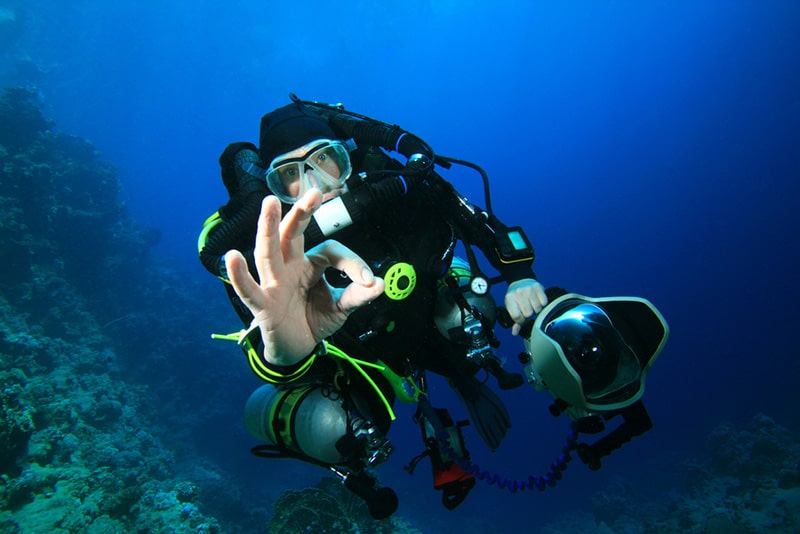
You probably should look into all three types of rebreathers and see what each of them can do for you. Depending on different user needs as well as diving levels, one type may serve well for you but is not ideal for other people.
1. Oxygen Rebreathers
Oxygen rebreathers provide you with a cylinder of pure oxygen as the primary source of breathing air, explaining why they cause oxygen toxicity easier than other types. In addition, this kind of rebreather requires the maximum operating depth, making it less attractive to advanced divers.
It is common knowledge that oxygen becomes toxic when you go deeper, which means most technical divers dive with nitrox instead of pure oxygen. However, if you do not plan to go beyond a limit of 20 feet, it is safe to inject 100% oxygen into your breathing hose.
See How Deep Can You Scuba Dive for more information if you are a first-time diver!
Thanks to technological advancements, oxygen rebreathers can offer you deeper dives up to 66 feet, though I believe they are usually quite risky. Nowadays, this type is no longer popular among the recreational divers’ community, mainly due to its depth limit.
Nevertheless, oxygen rebreathers are extensively used for military and mine rescue because of their simplicity, lightweight, and easy maintenance. Since they only offer pure oxygen to breathe, no electronic oxygen sensors are needed. You just have to purge them before and after diving.
Additionally, having a compact size means that oxygen breathers also serve as gas extenders for deep open-circuit dives. They help diffuse nitrogen in your body tissues more quickly, thereby convenient for those who want to make long decompression stops.
2. Semi-Closed Circuit Rebreathers
Scuba divers currently use semi-closed circuit rebreathers more frequently than oxygen models. That’s because they offer a deeper maximum operating depth and better safety.
Furthermore, these items use gas mixtures as the air supply, which completely removes the danger of oxygen toxicity.
Besides, semi-closed circuit rebreathers allow you to opt for diving with nitrox, trimix, or air during your dive; thus, you can go deeper. Electronic oxygen sensors are not required in this type, but they are often integrated to improve safety.
However, semi-closed rebreathers have some disadvantages. They are heavier, more cumbersome, and more complex than fully-closed models.
Moreover, excess gas is vented to the water in a stream of small bubbles, making this item the most wasteful among the three types.
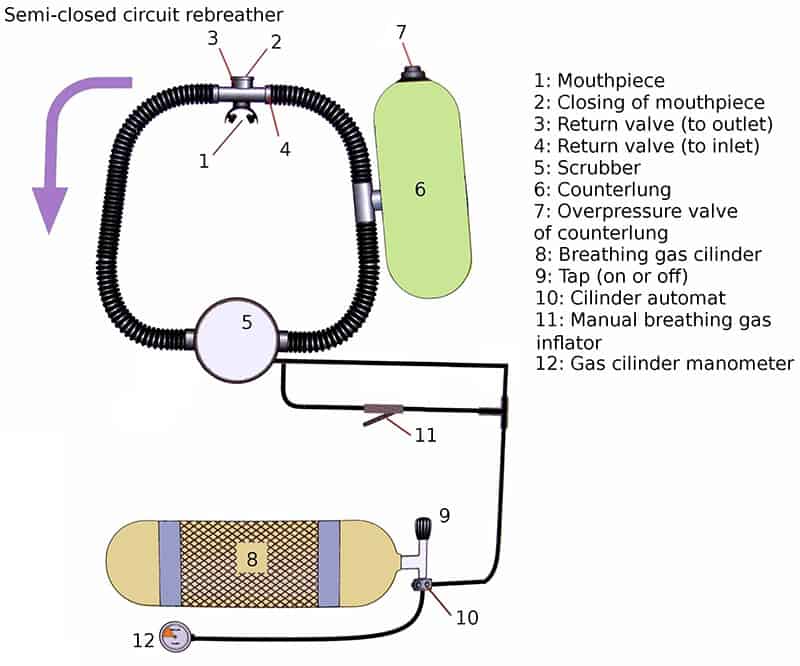
3. Fully-Closed Circuit Rebreathers
A fully-closed circuit rebreather combines the most significant advantages of the oxygen and semi-closed circuit models. It offers the most impressive depth limit and is the most commonly used type by technical divers today.
Instead of giving one cylinder, this kind comes in two: one for pure oxygen and one for diluent gasses such as air, nitrox, trimix, or heliox. Therefore, it requires accurate electronic oxygen sensors to monitor the oxygen partial pressure in the breathing hose.
This enables a fully-closed circuit rebreather to inform divers whether they are more likely to encounter hypoxia or hyperoxia.
In addition, another outstanding benefit of this type of rebreather is that it produces no bubbles, which means you get closer to sea creatures without bothering them.
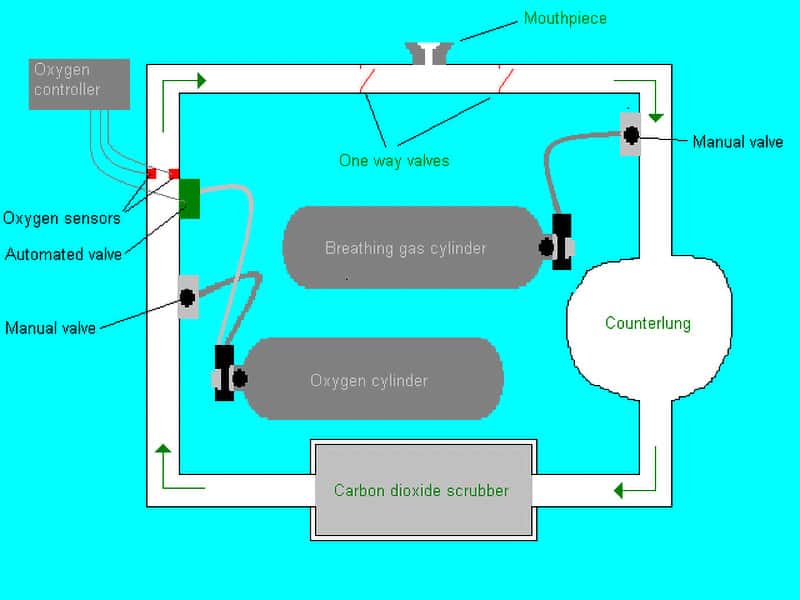
Advantages of a Rebreather
A rebreather is a considerable investment, so you may want to know whether it is worth buying. This part presents the four most significant benefits of the rebreather. I hope you find it helpful.
1. Gas Efficiency
Traditional scuba regulators expel entire breath into the surrounding water; hence, unused oxygen will not be recycled, commonly known as wasteful disposal. This makes deep-diving infeasible because a diver can only bring a limited number of scuba tanks.
However, just a small gas cylinder of a rebreather can enable you to stay underwater for up to three hours without decompression stops needed. The rebreather only replaces consumed oxygen while other gasses like nitrogen or helium remain unchanged during a dive.
2. Silence
Fully-closed circuit rebreathers produce no bubbles, making no bubble noise. Even a small stream of breathing gas vented from the hose of a semi-closed item cannot affect dolphins or sharks.
Thanks to that, it is effortless for you to get closer to observe magnificent sea life, coral reefs, etc. Professional photographers get many benefits because they can capture stunning footage without disturbing fish by the noisy gas hissing or underwater camera’s sound.
In addition, a rebreather is perfect for wreck and cave diving; you can go through narrow swim-throughs more easily without dislodging any loose materials.
3. Warm, Moist Breathing Air
The heat from chemical reactions in the carbon dioxide scrubber warms and humidifies your breathing air. Hence, some problems, including dry mouth and dehydration, will be prevented, which open circuit equipment can hardly offer.
More impressively, you can dive in cold water with a thinner wetsuit, but you don’t need to worry about being chilled or frozen. Besides, a sense of fatigue after a long dive is also reduced.
4. Other Upsides
Sophisticated fully-closed circuit rebreathers give you the ability to control gas mixture, and monitor the partial pressure of oxygen, resulting in enhanced safety. Also, you can choose to dive with less nitrogen, which means the possibility of decompression sickness is diminished.
Scuba divers can have more freedom to move in the water with a rebreather. Several semi-closed circuit models are even cheaper, more lightweight, and offer greater ease of use compared to expensive but bulky scuba regulators.
Rebreathers constantly maintain the total amount of gasses during a dive; thereby, almost no air is released from the breathing hose. This means that you cannot control your buoyancy by inhaling or exhaling.
One advantage of this situation is that no additional weight pockets are needed to compensate for gas consumption.
Disadvantages of a Rebreather
In addition to meaningful advantages, a rebreather can cause a few dangers if scuba divers use it in the wrong way. Failure operation and problems related to health are two fundamental considerations you should remember when using this gear.
1. Failure Modes
A few types of rebreathers are exclusively suitable for specific purposes. For example, oxygen rebreathers should only be used for shallow diving; meanwhile, semi-closed circuit rebreathers are perfect for intermediate diving due to their bulky and less efficient.
Most rebreathers rely on electronic sensors and alarms to ensure a safe breathing gas mixture. Therefore, if there are any malfunctions or improper configuration, they are susceptible to failure. Additionally, electronics are also vulnerable to water, requiring proper care.
Another dangerous case can occur when scuba divers cannot recognize signs of damage in their rebreathers. When a scuba regulator fails to operate, the lack of air supply can be realized immediately.
However, a rebreather is just a scuba device passing breathing gas between your lungs and cylinders. This process causes a few problems that happen mainly in the gas mixture. For instance, you still have enough air to breathe, but that air has too much or too little oxygen.
If the oxygen content is too high, it will lead to convulsions. If there is too little oxygen in your breathing air, it cannot sustain life or even cause nitrogen narcosis. But don’t worry because you still have enough time to deal with these problems as long as you always stay calm!
2. Safety Hazards
Misusing a rebreather may cause dangers to your life or even lead to death if you are not equipped with the essential skills to survive in emergencies. However, don’t be too scared because most of the related-rebreather health risks can be solved with proper training.
Hypoxia
Hypoxia occurs when the oxygen content in the gas mixture is too little, and the diluent gasses and carbon dioxide has been obliterated. When not having enough oxygen to breathe, divers are quickly unconscious as well as experience extreme respiratory distress and death.
Hyperoxia
When you dive beyond your limit or the maximum operating depth of an oxygen rebreather, your body absorbs too much oxygen, becoming poisonous. Another common reason causing hyperoxia is due to oxygen sensor malfunction.
If you use a rebreather for a long time, electronic oxygen sensors may not work correctly, which causes the system to inject more oxygen than necessary.
Frequently Asked Questions
In case you have any wondering problems about how a rebreather works, this section can clear your thoughts. Below are some of the most frequently asked questions accompanied by their short answers.
How Long Can You Stay Underwater on a Rebreather?
A rebreather is constructed with the aim to provide divers with longer bottom time, but smaller scuba tanks are required. Rebreather diving often lasts from one to three hours and up to six hours, depending on whether it is a semi-closed or fully-closed circuit.
How Much Does a Rebreather Cost?
The price of a rebreather is much higher than that of a regulator due to its complex constructions, adding to the fact that it requires more components. It is uncommon for regulators to cost over $5000, but this seems standard for rebreathers.
In some cases, you even have to spend up to $10000 for a high-quality model, though I believe its first-rate services will satisfy the most demanding diver.
How Deep Can You Dive With a Rebreather?
Since your breathing gas is recyclable thanks to a rebreather, your bottom time is not limited. Unlike traditional dive gear, whose functions are restricted to specific depths, technical divers using rebreathers can go 130 feet below the surface.
Conclusion
A rebreather is a tank of gas worn at your back to provide divers with plenty of air for easy breathing. It has various benefits but hinders numerous drawbacks as well. For inexperienced divers, it is crucial to grasp all the information about how a rebreather works.
A rebreather can allow you to dive underwater for hours, which is its selling point. In the meantime, you are likely to encounter hypoxia while using this equipment. Besides, if you have no idea which type of rebreather to buy, a full-closed circuit model should be preferred.
If you have other comments and questions for me, please post them in the comment section. Besides, you can help your friends know how to use a rebreather as well as its incredible benefits. Let’s do this by pressing any of the following social media buttons.

